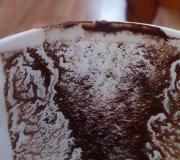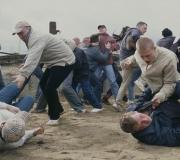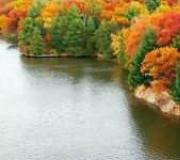Day of National Unity or Day of Harmony and Reconciliation. Day of National Unity or Day of Accord and Reconciliation Day of National Unity is celebrated with
On November 4, all of Russia will celebrate the Day of National Unity. Despite the fact that this is a relatively young holiday, its roots go back to the 17th century. Together we will figure out what kind of day this is and why it is confused with November 7th.
What happened on this day?
It was on November 4 (October 22, old style) 1612 that the people's militia, led by Kuzma Minin and Dmitry Pozharsky, stormed Kitay-Gorod, thereby freeing Moscow from Polish invaders.
The expulsion of the Poles from Moscow ended the long period of the Time of Troubles in Russia. After the expulsion of the Poles from Moscow, a new tsar was elected in Russia - a representative of the Romanov dynasty, Mikhail Fedorovich.
It is customary to refer to the events from the death of Tsar Ivan the Terrible (1584) to the election of the first sovereign from the Romanov dynasty, Mikhail Fedorovich (1613), as the Time of Troubles. After the death of Ivan the Terrible, his son Fyodor I Ioannovich ascended the throne. However, he had no descendants, and the Rurik dynasty came to an end. However, everyone remembered about the youngest son of Ivan the Terrible, Tsarevich Dmitry, who died under mysterious circumstances during Fyodor’s lifetime. People began to say that perhaps he was alive. It was from this moment that the Time of Troubles began in Russia, impostors of False Dmitry began to lay claim to the throne.
When did National Unity Day become a holiday?
In 1613, Tsar Mikhail Fedorovich established a holiday - the day of the cleansing of Moscow from Polish invaders. It was celebrated on November 4th.
In 1649, this day was declared an Orthodox state holiday of the Kazan Icon of the Mother of God. According to legend, the icon was sent from Kazan to Dmitry Pozharsky. With her, the militia entered Moscow. Many believe that it was thanks to the icon that the Poles were driven out.
After the 1917 revolution, the tradition of celebrating the liberation of Moscow from Polish invaders ceased.
In September 2004, the Interreligious Council of Russia proposed making November 4 a holiday and celebrating it as National Unity Day. The initiative was supported in the State Duma, and this day became a day off instead of November 7.
Why was the holiday called National Unity Day?
The explanatory note to the draft law on the introduction of a new holiday states the following:
“On November 4, 1612, the war of the people’s militia led by Kuzma Minin and Dmitry Pozharvsky took China Town by storm, liberating Moscow from Polish invaders and demonstrating an example of heroism and unity of the entire people, regardless of origin, religion and position in society.”
How is National Unity Day celebrated?
National Unity Day is a public holiday, the day of military glory of Russia. In 2019 it is celebrated on November 4th. This is an official holiday in the country. The holiday is associated with the liberation of Moscow from Polish invaders in 1612 and symbolizes national unity. It is dedicated to the Day of the Kazan Icon of the Mother of God. It is celebrated by all citizens of the Russian Federation. In 2019, National Unity Day is celebrated for the 15th time.
history of the holiday
On November 4 (October 22, old style), 1612, the people's militia under the leadership of Kuzma Minin and Dmitry Pozharsky stormed Kitay-Gorod and liberated Moscow from the Polish-Lithuanian invaders. Russian troops marched to the Kremlin in a religious procession with the Kazan Icon of the Mother of God - the defender of the Russian land. In 1630, the Kazan Cathedral was built on Red Square. In 1649, Tsar Alexei Mikhailovich declared November 4 a public holiday - the Day of the Kazan Icon of the Mother of God, in memory of the liberation of Moscow from the Polish-Lithuanian troops. After the October Revolution of 1917, the tradition of celebrating this celebration was interrupted.
In September 2004, the Interreligious Council of Russia proposed establishing a holiday on November 4 - National Unity Day. Decree of the President of the Russian Federation V. Putin No. 200-FZ of December 29, 2004 amended Article 1 of the Federal Law of March 13, 1995 No. 32-FZ “On days of military glory and memorable dates of Russia” and Article 112 of the Labor Code of the Russian Federation No. 197- Federal Law of December 30, 2001. November 4 - National Unity Day became a day of military glory and a holiday.
Holiday traditions
National Unity Day is a young holiday that is celebrated magnificently and solemnly. Its goal is to unite the people of Russia, regardless of social status, nationality or religion. On this day, citizens of the country remember the historical event to which this celebration is dedicated and organize mass events.
Political parties hold rallies and parades. Craft fairs, entertainment programs for adults and children, and exhibitions are organized in city squares. Charity events are held in many cities. Action participants collect things, toys, books, money and donate them to orphanages, homes for disabled children and boarding schools.
Free food and drink distribution points are organized at the celebration sites. In the evening, concerts are held where pop stars, dance and music groups perform.
The main place of celebration is Red Square in Moscow. The event begins with a solemn procession through the city and ends with the laying of bouquets at the memorials to Elder Minin and Prince Pozharsky. The President makes a festive speech to the citizens of the Russian Federation and presents State awards.
The celebration takes place on a special scale in Nizhny Novgorod, the birthplace of Kuzma Minin. On November 4, city authorities open public facilities: bridges, schools, kindergartens, parks. The main events take place on National Unity Square, where a monument to Minin and Pozharsky is erected. There is a big concert and fireworks display.
Since 2001, the public patriotic event “Altar of the Fatherland” has been held. It involves social activists, cultural workers, students, and schoolchildren. They repeat the path of the militia, which begins in Nizhny Novgorod and ends in Moscow on Red Square.
Congratulations
Happy National Unity Day!
Let our people be united.
We want to feel pride in the country,
Move forward boldly and confidently.
May this holiday add strength to you,
Let a wave of good luck wash over you.
Let the sun of happiness shine over you,
Together we are one great country!
On National Unity Day
My congratulations.
I wish you and your loved ones happiness,
Kindness, respect for each other.
I also wish you strength, strength,
Important aspirations, successful ideas.
So that there is always warmth in your heart,
And he had love for his Fatherland.
What date is National Unity Day in 2020, 2021, 2022
| 2020 | 2021 | 2022 |
|---|---|---|
| 4 November Wed | 4 November Thu | 4 November Fri |
For the first time, Russia celebrated National Unity Day on November 4, 2005, after the President of the Russian Federation signed the corresponding order in 2004. National Unity Day has become an all-Russian holiday.
Brief history of the holiday
The history of the holiday dates back to the end of the reign of the Rurik dynasty. This, according to modern historians, was precisely what caused the beginning of the so-called Time of Troubles, when, against the backdrop of the development of serious economic problems and the weakness of the ruling government, a foreign invasion of the territory of our state was carried out. In short, the prerequisite for the emergence of this holiday can be considered the gratitude of the Russian people for their help in expelling the Polish invaders.
Due to the difficulties that arose in the power structures during the division of power and the resulting unrest in the regular army, there was a need to create a people's militia to repel the invasion from Poland. The first attempt, unfortunately, ended in complete failure of all plans. However, in 1611 in Nizhny Novgorod, under the leadership of the acting headman Kuzma Minin, a second attempt was made to organize a capable people's militia. Under the leadership of Minin and with the consent of the townspeople themselves, a monetary collection was developed and approved for the creation, arming and full maintenance of a new people's militia.
Dmitry Pozharsky was elected chief governor of the militia, who attracted not only ordinary townspeople or peasants, but also representatives of eminent noble families into the ranks of the militia. The main task of the militia under the leadership of Dmitry Pozharsky was to repel the Polish invasion and prevent a foreign ruler from coming to power in the country.
At the beginning of March 1612, the militia moved towards the city of Yaroslavl. And on November 4, 1612, the first people's militia, created on a voluntary basis, led by Dmitry Pozharsky, stormed Kitay-Gorod and drove the Polish invaders out of Moscow.
Throughout the struggle, the militia were under the protection of the icon of the Blessed Virgin Mary, which as a result was placed in the Kazan Cathedral, built with Pozharsky’s personal funds.
The consequence of this victory was the coronation and coming to power in the country of the new Russian Tsar - Mikhail Romanov. And on November 4, 1649, the ruling authorities in the country approved a new holiday, as an act of gratitude to the Blessed Virgin Mary for her help in the fight against foreign invaders.
After the 1917 revolution, the celebration of this day was abolished due to the total struggle against any religious beliefs. But in 2004, this holiday reappeared in Russia.
Today it is a holiday that reminds us of the nobility of our multinational people, of their readiness to unite to repel external attacks, of the greatness of the people living in our country, of the numerous resounding victories over the enemy.
Holiday traditions
Today this holiday symbolizes the unity of the people, thanks to which it was possible to defeat the Polish invaders.
This holiday provides an opportunity not only to remember one of the great victories, but also reminds Russians that Russia is a multinational country and only through joint efforts can the enemy be defeated. To this day, lush and grandiose patriotic celebrations take place in all cities of the Russian Federation. Folk festivities include fun entertainment programs, concerts and fireworks.
The essence and meaning of the holiday National Unity Day 2018
On this day, 3 interconnected events are celebrated:
- Day of Military Glory;
- Day of the Kazan Mother of God is a church holiday;
- National Unity Day.
On November 4, 1612, the people's militia led by Kuzma Minin and Dmitry Pozharsky stormed Kitai Gorod, they liberated Moscow from Polish invaders. In general, this is a decisive, turning point, during which the heroism and unity of the entire people were demonstrated. Everyone stood up to defend the Motherland, regardless of origin and religion.
National Unity Day 2018 in modern Russia
For a long time, at the very beginning of November, our country celebrated the anniversary of the October Revolution. After the collapse of the USSR, this holiday was replaced by the Day of Harmony and Reconciliation.
The idea of reviving in people's memory the celebration of the end of the Time of Troubles and the image of the Kazan Mother of God was expressed by the Interreligious Council of Russia in September 2004. After amendments were made to the Labor Code, the State Duma decided that November 4 would be recognized as National Unity Day.
Since 2005, all of Russia has been celebrating National Unity Day on November 4; this day is an official holiday and falls during the autumn holidays for schoolchildren. Traditionally, on this day in the Kremlin, the President of the Russian Federation presents state awards to outstanding figures of science and art, as well as foreign citizens for their great contribution to strengthening friendship and developing cultural ties with Russia. Rallies, marches and demonstrations are taking place in Russian cities.
The holiday was established by the Federal Law “On the inclusion in Article 1 of the Federal Law “On the Days of Military Glory (Victory Days) of Russia”, signed in December 2004 by Russian President Vladimir Putin.
National Unity Day was established in memory of the events of 1612, when the people's militia led by Kuzma Minin and Dmitry Pozharsky liberated Moscow from Polish invaders. Historically, this holiday is associated with the end of the Time of Troubles in Russia in the 17th century. The Time of Troubles - the period from the death of Tsar Ivan the Terrible in 1584 until 1613, when the first of the Romanov dynasty reigned on the Russian throne - was an era of deep crisis in the Moscow state caused by the suppression of the royal Rurik dynasty. The dynastic crisis soon developed into a national-state crisis. The united Russian state collapsed, and numerous impostors appeared. Widespread robberies, robbery, theft, bribery, and widespread drunkenness struck the country.
It seemed to many contemporaries of the Time of Troubles that the final ruin of the “blessed kingdom of Moscow” had occurred. Power in Moscow was usurped by the “Seven Boyars” led by Prince Fyodor Mstislavsky, who sent Polish troops into the Kremlin with the intention of placing the Catholic prince Vladislav on the Russian throne.
In this difficult time for Russia, Patriarch Hermogenes called on the Russian people to defend Orthodoxy and expel the Polish invaders from Moscow. “It’s time to lay down your soul for the House of the Most Holy Theotokos!” - wrote the patriarch. His call was taken up by the Russian people. A broad patriotic movement began for the liberation of the capital from the Poles. The first people's (zemstvo) militia was headed by the Ryazan governor Prokopiy Lyapunov. But due to infighting between the nobles and the Cossacks, who killed the governor on false charges, the militia disintegrated. The anti-Polish uprising that began prematurely in Moscow on March 19, 1611 was defeated.
In September 1611, the “trading man”, Nizhny Novgorod zemstvo elder Kuzma Minin, appealed to the townspeople to create a people’s militia. At a city meeting, he made his famous speech: “Orthodox people, we want to help the Moscow state, we will not spare our bellies, and not just our bellies - we will sell our yards, we will pawn our wives and children and we will beat our heads so that someone will become our boss. And what praise will all of us receive from the Russian land that such a great thing will happen from such a small city as ours.”
At Minin’s call, the townspeople voluntarily gave “a third of their money” to create a zemstvo militia. But voluntary contributions were not enough. Therefore, a forced collection of “fifth money” was announced: everyone had to contribute a fifth of their income to the treasury of the militia for the salaries of serving people.
At Minin’s suggestion, the 30-year-old Novgorod prince Dmitry Pozharsky was invited to the post of chief governor. Pozharsky did not immediately accept the offer; he agreed to be a governor on the condition that the townspeople themselves would choose an assistant for him who would be in charge of the treasury of the militia. And Minin became “the elected man of the whole earth.” So at the head of the second zemstvo militia were two people elected by the people and invested with their complete trust.
a huge army for that time - more than 10 thousand serving local people, up to three thousand Cossacks, more than a thousand archers and many "dacha people" from the peasants.
Representatives of all classes and all peoples that were part of the Russian state took part in the national militia, in the liberation of the Russian land from foreign invaders.
With the miraculous icon of the Kazan Mother of God, revealed in 1579, the Nizhny Novgorod zemstvo militia managed to storm Kitay-Gorod on November 4, 1612 and expel the Poles from Moscow.
This victory served as a powerful impetus for the revival of the Russian state. And the icon became the subject of special veneration.
At the end of February 1613, the Zemsky Sobor, which included representatives of all classes of the country - the nobility, boyars, clergy, Cossacks, archers, black-growing peasants and delegates from many Russian cities, elected Mikhail Romanov (son of Metropolitan Philaret), the first Russian Tsar from the dynasty, as the new Tsar Romanovs. The Zemsky Sobor of 1613 became the final victory over the Troubles, the triumph of Orthodoxy and national unity.
The confidence that it was thanks to the icon of the Kazan Mother of God that the victory was won was so deep that Prince Pozharsky, with his own money, specially built the Kazan Cathedral on the edge of Red Square. Since then, the Kazan Icon began to be revered not only as the patroness of the House of Romanov, but by decree of Tsar Alexei Mikhailovich, who reigned in 1645-1676, a mandatory celebration was established on November 4 as a day of gratitude to the Most Holy Theotokos for her help in liberating Russia from the Poles (celebrated before 1917). This day was included in the church calendar as the Celebration of the Kazan Icon of the Mother of God in memory of the deliverance of Moscow and Russia from the Poles in 1612.
Thus, National Unity Day is essentially not a new holiday at all, but a return to an old tradition.
On National Unity Day, in different cities of our country, political parties and social movements organize rallies, processions and concerts, charity events and sporting events.
The material was prepared based on information from RIA Novosti and open sources
People familiar with history know that this date - National Unity Day - is dedicated to the events of the Time of Troubles, when Moscow was liberated from enemies in 1612 with the help of a militia consisting of ordinary people, led by Minin and Pozharsky.
A reason to create a new holiday in Russia
Initially, the residents of our country celebrated November 7 as the anniversary of the well-known October Revolution. The Soviet Union collapsed, and people, by inertia, continued to celebrate this day, since it remained red on the calendar. Only now it was called. This continued for another 14 years after the collapse of the USSR, until the authorities decided that it was time to establish a new date. So what is the name of the November 4th holiday in Russia?
Alexy II, Patriarch of Russia at that time, at the Interreligious Council came up with the idea of reviving in the memory of people the end of the Time of Troubles and the image of Our Lady of Kazan. So that the people do not have unnecessary questions about what holiday is celebrated in Russia on November 4, the State Duma, after amending the Labor Code, decided that this date will be recognized as the Day of National Unity.
People's militia led by Minin and Pozharsky
At the beginning of the 17th century, Russia was in the grip of the Time of Troubles. The country was experiencing severe crises related to politics and economics, crop failures and famines, and foreign intervention. In 1612, she freed herself from the Poles with the help of Kozma Minin, a governor from Nizhny Novgorod, and Prince Dmitry Pozharsky. They organized which captured Kitay-Gorod and forced the foreigners to recognize the act of surrender.
Pozharsky was lucky to be the first to enter the city. He carried in his hands the icon of the Kazan Mother of God. In Rus' they sincerely believed that it was the Mother of God who protected the people from enemies at that time. In 1649, by decree of Tsar Alexei Mikhailovich, November 4 became dedicated to the Lady of Heaven. Until 1917, until the revolution took place in the country, this day was special for all Russian people.

Celebration of the Kazan Icon of the Virgin Mary
Now the Orthodox also especially honor this day. What kind of holiday is November 4th in Russia? This is the day of glorification of the Kazan Mother of God. In 1612, he appealed to the people to pray and stand up for the defense of their native land from foreign invaders. Then a miraculous image of the Ever-Virgin Mary was sent to the militia to Dmitry Pozharsky from Kazan. Having endured a three-day fast, people with faith and hope appealed to the Queen of Heaven with a request that she give them strength to defeat their enemies.
The Mother of God heard their pleas for help, Moscow was liberated. Then the Time of Troubles in Rus' came to an end. Since then, people have known about the miraculous salvation of the country on November 4, which is now considered a holiday in Russia. In honor of this event, the Kazan Cathedral was built on Red Square in 1612. It was destroyed during the years of persecution of the church, and has now been restored.

The people's contradictory attitude towards this event
Many people do not understand what kind of date November 4th is, what holiday is celebrated in Russia at this time? Not everyone knows about National Unity Day, in particular, the older generation is accustomed to the date of November 7, when the events of the 1917 revolution are remembered. People who grew up in the spirit of atheism do not want to recognize the new holiday. They still celebrate theirs 3 days later. The communists in the State Duma were also initially against rearranging the date in the calendar, however, their votes were in the minority and did not have a significant influence on the decision.
Thus, some people believe that it is not good to violate old traditions by shifting the emphasis from one holiday to another, while others (including many Orthodox Christians), on the contrary, are sure that this day is a revival of history. Everything returns to its place. But for 10 years now, November 4th has been celebrated. What kind of holiday is it in Russia without the opportunity to relax? This day is an official holiday.

National Unity Day or Harmony and Reconciliation Day?
Until now, some people are confused and cannot say which name of the holiday is correct. In this case, it will not matter whether each individual person knows what the November 4 holiday is called in Russia. The main thing is that people understand the meaning of this date in the calendar. The Russian people have always been famous for their unity and conciliarity in decision-making. This is how Russia was able to win many wars.
On this day, all contradictions and disagreements that provoke conflict situations should be forgotten. People need to become kinder to each other, since the roots of entire generations are closely intertwined. Only then will the meaning of what is celebrated on November 4 (which is a holiday in Russia) reach every person.

How is National Unity Day going?
Times change. Now more and more people are welcoming the introduction of November 4th. What holiday in Russia takes place without gala concerts and various events? Various events are dedicated to this day: demonstrations, mass processions, distribution of free gifts with state symbols.
A government reception is held in the Kremlin Hall, where people who have made a huge contribution to the development of the country receive their well-deserved awards. In the evening, traditional folk festivities are held, and it all ends with bright volleys of fireworks, so that the people will forever remember the date November 4th, what kind of holiday is celebrated in Russia on this day.




